All about ekiben, Japanese train station bentos
(First off, my apologies for the long silence around here. I've been terribly sick since getting back from Japan last week, due to a bad cold that I seem to have picked up on the long journey home. I'm slowly getting back into the swing of things though. Anyway, back to bentos!)
I've always contemplated getting a Japan Rail (JR) Pass to do some extended travel around Japan by train, but until this most recent trip back I've never done so, due to time and budgetary constraints. This time around, I knew that there were two long trips on the Shinkansen bullet train in the works, so I took that as an excuse to splurge on a 14-day JR Pass. I didn't ride the rails every single day of those 14 days, but I did take several trips and got to see parts of Japan that I'd never seen before. And of course, I indulged in several ekiben or station bentos along the way.
I've talked briefly about ekiben before. Of all the different manifestations of bentos that exist in Japan, ekiben occupy a special place. They're not just dull meals to fill up hungry travelers, like airline meals or the boring sandwiches and such that you get on European trains. The best ekiben provide a small window into the regional cuisine and culture of the place where the bento is produced. The people who make and sell these bentos do so with great thought and pride in what they do. They're regarded as a means of drawing tourists and bringing fame and fortune to the region. For travellers, they're just plain fun.
Where to buy ekiben
In urban areas, ekiben are sold mainly at train stations with long-distance trains going in and out. You won't find ekiben at stations with only regional commuter lines or subway/metro lines. So for example, while Tokyo Station has hundreds of ekiben for sale by multiple vendors, Ginza Station has none (or just a couple that target residents and commuters). Out in the countryside, you may find ekiben for sale at larger train stations on local lines, though the number of really regional ekiben sellers is sadly dwindling.
If you're taking the Shinkansen anywhere, you will be spoiled for choice when it comes to bentos. Every Shinkansen platform has at least one store or pushcart selling ekiben. Here's an ekiben kiosk at Tokyo Station.
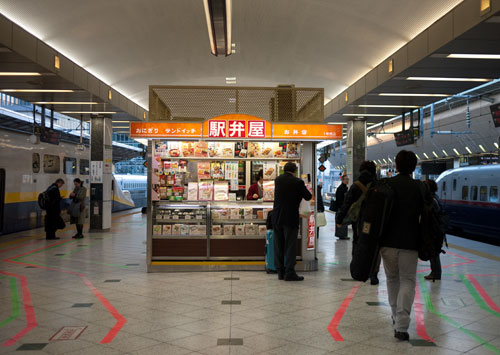
Here's one at Sendai Station, with the nose of a Shinkansen train passing by.
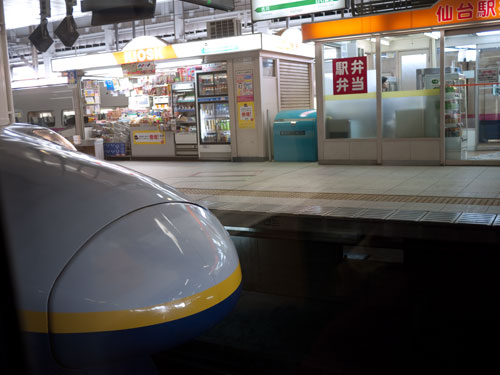
And this more elaborate booth is at Morioka Station in Iwate prefecture up north.

You can also find other ekiben vendors along the corridors going to the platform, as well as in the shopping malls and depachika (department store food halls) that are attached to large train stations. And if you forget or just don't have the time to buy one before you get on the train, don't worry - most long distance trains, including the Shinkansen, sell bentos, snacks and beverages from food trolleys on board.
Soraben (空弁) are basically ekiben that are sold at airports (kuukou) rather than stations (eki). In the Tokyo area Haneda airport has far more ekiben sellers than Narita does. Presumably domestic travellers buy bentos more than international ones. (Note: Haneda has recently resumed international flights.)
How to buy ekiben
Buying ekiben is simplicity itself. They are set up to be easy to choose and just grab and go. More often than not you'll see a display of the bentos for sale, either the real thing or plastic models, with prices clearly marked. All you have to do is point and buy. This is the display at Morioka Station.

How much do they cost?
Prices range from as low as 300 yen for a small snack bento to above 3000 yen for elaborate bentos. Most full meal size bentos are in the 700 to 1200 yen range.
Are there ekiben guidebooks?
Yes - in Japanese only though. You don't really need one unless you are dead serious about trying particular ekiben. Just grab what appeals to you, or ask someone from the area what they recommend.
Am I stuck eating rice if I do an ekiben tour?
Most ekiben are rice based, but you can also find noodle bentos, dumplings and more. You can also go for sandwiches, donuts or sweet pastries at the bakery/coffee stalls if you wish.
What is there to drink?
Anything that is sold at a Japanese kiosk or from a vending machine is available, from hot or cold teas or coffees to soft drinks and more. You can also buy beer, sake and other alcoholic beverages. (If you're on a long distance train at night, you may encounter people eating ekiben and getting tipsy. Most of the time they don't get drunk enough to be bothersome.)
So let's look at some ekiben!
These are just some of the ones that I had in the past few weeks. I think I have a few thousand more to go before I've tried every single ekiben in Japan. Not only do I love eating ekiben, they also give me tons of ideas for homemade bentos.
These are small snack bentos (4-600 yen each) that we ate for breakfast on an early morning Shinkansen departing from Tokyo Station. There's a packet of 3 onigiri wrapped in a real bamboo leaf, and a packet of delicate ham and butter sandwiches in a pretty retro design box.
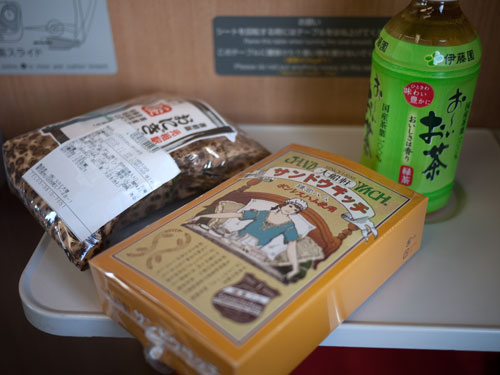
The sandwiches may look boring, but were really delicious. The box proudly proclaimed the provenance of the ham used (kurobuta pork cured by an old charcuterie in Kamakura).
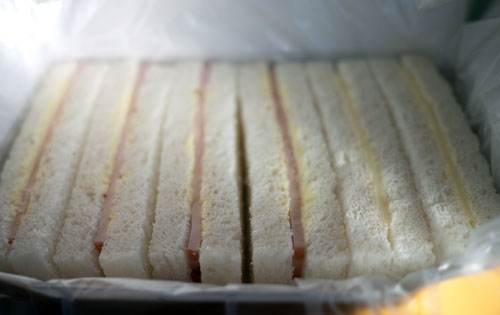
This is a bento sold at a regional train station, Ohdate in Akita prefecture. It's called torimeshi bento (chicken-rice bento) and is so famous that people make a detour to Ohdate just to pick up these bentos. They feature free range happy chicken meat cooked in a soy sauce-based sauce in rice. This huge, filling and delicious bento is just 850 yen (about US $10).
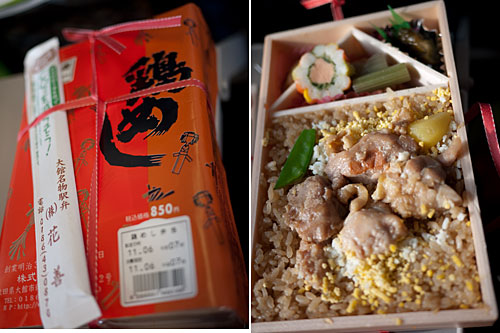
This is a wappameshi bento, packed in a wappa or bent "wood" box, also from Akita. (Sadly the box isn't made of wood, but of disposable wood grain-printed styrofoam.) The actual contents look remarkably like the photo on the kakeshi or paper wrapping. There's a bed of delicious akitakomachi rice under all the goodies you see. It, too, was delicious, if a trifle salty.

This is a yakisoba (stir fried noodle) bento, with a twist. When you pull on a string on the side of the bento box, the box heats up with a whooshing sound. It sounds good in theory, but in practice the box gets a bit too hot to handle with bare hands or balance on ones knee, while the insides don't get that hot. Plus, it makes the whole train compartment starts to smell like halfway-heated noodles, which may not be appreciated by your fellow passengers. At least it was fairly tasty, filling and cheap (800 yen).

On the other end of the price scale is this elaborate bento for two, purchased at Kyoto Station. It cost 3200 yen or so, but was worth it I think - it was so beautiful and delicious.
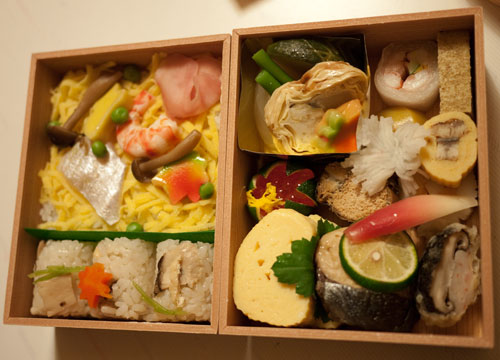
Here are several sushi bentos. Most sushi sold as ekiben features cooked or processed (salted, marinated, smoked, etc.) fish. If raw fish sushi is sold, you're reminded several times to eat it right away. This temarizushi bento from Kyoto Station is a favorite that I keep going back to again and again. It's about 1300 yen. (Yes, Kyoto tends to be more expensive.)
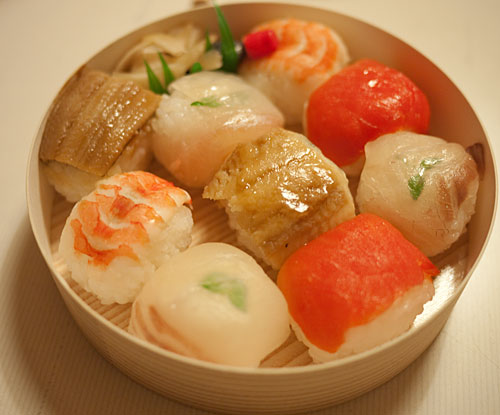
This is a kanizushi (crabmeat sushi) bento bought and consumed on the Hokuriku Honsen line going from Kanazawa to Echigo Yuzawa, along the Japan Sea side of the country. It's a chirashizushi - a bed of sushi rice with tons of sweet cooked crabmeat on top. I thought about saving the cute crab shaped baran, but it was a bit too crabby.
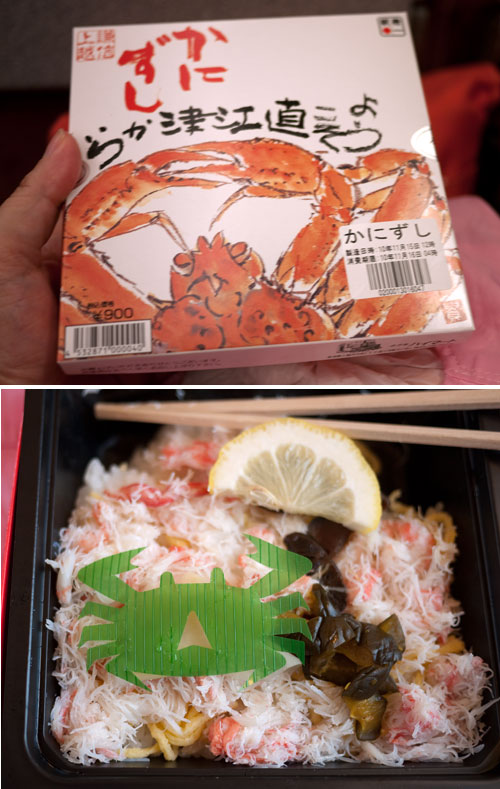
This is another kind of ekiben sushi, oshizushi (pressed sushi) purchased at Matsumoto Station, in Nagano prefecture. All the fish used here is pre-processed (salted or marinated in vinegar). Each piece is wrapped individually in plastic, which isn't too eco-friendly, but is handy if you're too full to finish the sushi in one go.
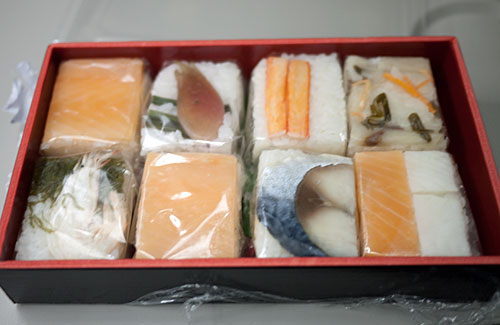
These little wrapped sushi are a definite step up. They are wrapped in fresh persimmon (kaki) leaves and are called kaki no ha sushi. They're from Kyoto Station again, from the Isetan department store food hall. Each one features a small square of pressed sushi rice topped with a piece of crabmeat, cured salmon, omelette and so on.
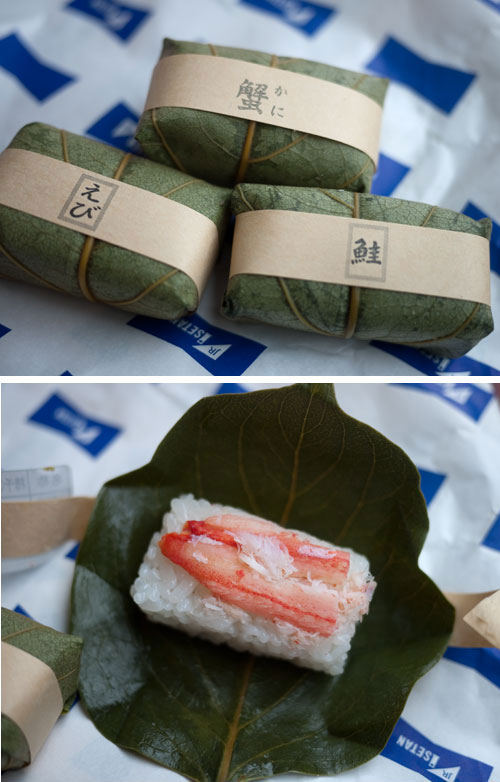
And finally, here's the ekiben that is still my favorite - the scallop rice bento from Kiyoken in Yokohama, featured here in detail. I like it so much because it's so well balanced, and even includes a little dessert. It's available at Yokohama and Shin Yokohama stations and is 980 yen.
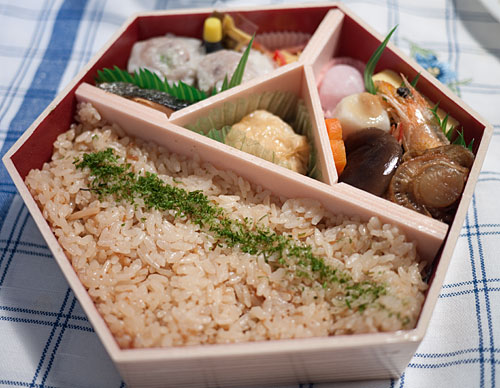
So there you have it. I hope that it gives you some inkling as to the variety of ekiben available. If you decide to go on an ekiben trip of your own after reading this, please let me know. ^_^
If you enjoyed this article, please consider supporting this site by becoming my patron via Patreon.
